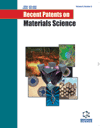-
s In situ Synthesis of Ruthenium Supported on Ginkgo Leaf-Derived Porous Carbon for H2 Generation from NH3BH3 Hydrolysis
- Source: Recent Patents on Materials Science, Volume 11, Issue 2, Oct 2018, p. 65 - 70
-
- 01 Oct 2018
Abstract
Background: Hydrogen is considered a clean energy carrier. Ammonia-borane (AB, NH3BH3) has been attracted considerable attention as a potential chemical hydrogen storage material. Objective: To improve the catalytic activity for hydrogen production of AB hydrolysis, to develop a catalyst with high activity is urgently needed. Method: The patents relating to the catalytic hydrolysis of AB for hydrogen production are reviewed. We successfully synthesized ginkgo leave-derived carbon by pyrolysis and chemical activation. Then, ruthenium particles were supported on this porous carbon (Ru/GC) by in situ reduction. Results: The as-prepared Ru/GC catalysts for AB hydrolysis exhibit high activity (TOF = 921 molH2·molRu -1·min-1) and low activation energy (Ea = 23.86 kJ·mol-1). Moreover, fairly good recyclability with 58% of the initial catalytic activity is retained after five cycles. Conclusion: The high catalytic performance and easy preparation demonstrate that Ru/GC is a highly efficient catalyst towards AB hydrolysis.


